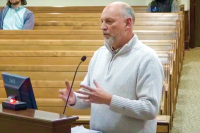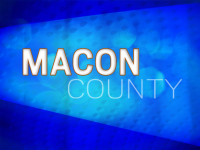Four elk dead in Jonathan Creek
 After three elk were shot on the Ross dairy farm in Jonathan Creek for eating winter wheat, a follow-up visit from wildlife officials revealed the remains of a fourth elk as well.
After three elk were shot on the Ross dairy farm in Jonathan Creek for eating winter wheat, a follow-up visit from wildlife officials revealed the remains of a fourth elk as well.
“I love the elk myself, but I don’t like them tearing my fence and getting in my hayfield and running my cattle, and they (wildlife managers) haven’t done anything about it and I had to do a little bit myself to defend my business,” said landowner Ralph Ross.
To be clear, Ross himself did not shoot the elk. He runs a dairy farm on land adjacent to farmland run by his two sons, and the elk shootings happened on that adjacent property. However, the entire Ross family has been involved in various elk-related conflicts through the years — it’s not the first time an elk has met its end on Ross land after damaging property.
“I have elk on the property every day, 40 and 50 elk every day,” Ross said.
The three elk that initially drew wildlife managers to the scene were shot on Jan. 29 while eating a winter wheat crop on the Ross property, according to Lt. Sam Craft of the N.C. Wildlife Resources Commission.
“It was a substantial amount of damage,” said Craft, who has not visited the site but is tasked with speaking for the Wildlife Commission on the matter based on submitted reports. “There had been elk there before and our officers and biologists had witnessed the elk in the farmer’s crops.”
Related Items
Of the three elk, one was a bull, one was a cow and one was a calf, Craft said, though Ross takes issue with the word “calf.”
“They was a bull elk and a yearling female elk and a larger elk,” Ross said. “They was no baby elk killed on the farm.”
The Wildlife Commission learned of the incident from the Ross family, receiving a call letting them know the elk had been shot. Under North Carolina law, landowners have the right to kill any wild animal causing property damage on their land, and there is no requirement that they contact authorities before or after shooting. Therefore, nobody will face criminal charges related to the shootings, Craft said.
Following the report, wildlife officials went out to investigate and also consult with the family on measures they could take to reduce conflict in the future, Craft said. That’s when the fourth elk, a bull, was discovered — on a property adjacent to the property where the three were shot but still within the Ross holdings.
“At this time all of those deaths appear to be lawfully taken by the landowner because they were in the act of depredation,” said Craft.
The law protects landowners who shoot wild animals committing property damage but does not spell out a particular threshold of damage at which it’s appropriate to shoot. There’s not a distinction spelled out between the damage caused when an elk leaves a muddy hoof print in someone’s yard and when it knocks down hundreds of dollars’ worth of fencing.
In a herd with an estimated size of 150 to 200 animals, the loss of four elk is substantial, representing about 2 percent of the total population. Kim DeLozier, conservation program manager for the N.C. Rocky Mountain Elk Foundation and a former park biologist who was instrumental in the elk’s 2001 reintroduction to North Carolina, said it’s disappointing to see death tolls this big.
“There’s a tremendous amount of frustration,” DeLozier said. “I think there’s a lot of people who support elk. There are a few people who do not.”
Elk bring a lot of value to the state, especially through tourism, he said, and while it’s understandable that a farmer who must add a continual struggle to save his crops from elk into his list of tasks might not love their presence, there has to be a way to strike a balance. The Rocky Mountain Elk Foundation, he said, has been meeting with the farmers to look for solutions and possibly some money to carry them out but obviously wasn’t able to find a fix soon enough.
“If we can put people on the moon, sure to goodness we can come up with a plan to keep these elk off of some property owned by a farmer,” DeLozier said.
Ross, meanwhile, maintains that the elk were set loose on National Park Service land and that the Park Service should take responsibility to keep the animals from becoming everybody else’s problem.
“We wouldn’t be bothered with the elk anytime if they was to feed them on Catalooch,” he said. “That’s what they’re doing, coming after our good grass and wheat fields.”









